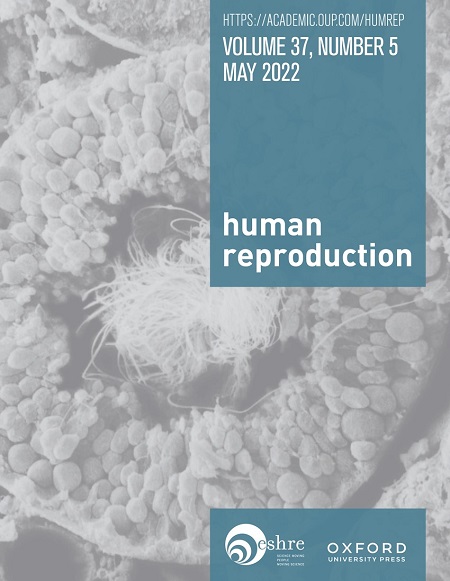Reclassifying NOBOX variants in primary ovarian insufficiency cases with a corrected gene model and a novel quantitative framework
IF 6
1区 医学
Q1 OBSTETRICS & GYNECOLOGY
引用次数: 0
Abstract
STUDY QUESTION How updated expression and genomic data combined with a disease/disorder-specific classification system can be used to correct a gene model for a better evaluation of the pathogenicity of variants found in patients? SUMMARY ANSWER By combining available genomic and transcriptomic data from several species and a quantitative classification framework with primary ovarian insufficiency (POI)-adjusted parameters, we correct the human NOBOX (newborn ovary homeobox) gene model and provide a reclassification of variants previously reported in POI cases. WHAT IS KNOWN ALREADY The NOBOX gene, encoding a gonad-specific transcription factor with a crucial role in early folliculogenesis and considered a major gene involved in POI, is currently described as being expressed as four transcripts, the longest one considered canonical. All the variants identified in POI cases have been evaluated according to this canonical transcript, and the various functional tests have been performed using the corresponding predicted protein. STUDY DESIGN, SIZE, DURATION We refined and corrected the NOBOX gene model using available genomic and RNAseq data in human and 16 other mammalian species. Expression data were selected for tissue specificity, strand specificity, and coverage. The analysis of RNAseq data from different ovarian fetal stages allows for a time-course description of NOBOX isoforms. Literature was scanned to retrieve NOBOX variants reported in POI cases, and NOBOX variants present in ClinVar and GnomAD 4 databases were also retrieved. PARTICIPANTS/MATERIALS, SETTING, METHODS Strand-specific RNAseq data from human fetal ovaries and human adult testes were analysed to infer the correct human NOBOX gene isoforms. The conservation of the gene structure was verified by combining the aligned genomic sequences from 17 mammalian species covering a wide phylogenetic range and the relevant RNAseq data. As changing a gene model implies a reclassification of variants, we set up a quantitative framework with updated variant frequencies from GnomAD4 and POI-adjusted parameters following the American College of Medical Genetics and Genomics/Association for Molecular Pathology (ACMG/AMP) guidelines. Using this framework, we reclassified 44 NOBOX variants reported in POI patients and families, 117 NOBOX variants reported in ClinVar, and 2613 NOBOX variants present in GnomAD4. MAIN RESULTS AND THE ROLE OF CHANCE The corrected NOBOX gene model proposes the invalidation of two transcripts, including the canonical one. The two correct isoforms were present in fetal ovarian samples, and only one was detected in adult testes. Only 14 variants remained as possibly causative for POI. Furthermore, this re-evaluation strongly suggests that NOBOX biallelic variants are the most likely cause of POI. LARGE SCALE DATA Large tables are provided as supplementary data sets on the Zenodo repository. LIMITATIONS, REASONS FOR CAUTION The proposed gene model is robust but relies on available transcriptomic data covering a range of time points and tissues. Our scoring system was manually adjusted and other laboratories can implement it with different parameters. WIDER IMPLICATIONS OF THE FINDINGS For the NOBOX variants that cannot be considered pathogenic or causative anymore, the genome/exome sequencing data of the corresponding patients should be reanalysed. Furthermore, the functional studies performed using the obsolete coding sequence should be reconsidered. The corrected gene model should be taken into account when evaluating novel NOBOX variants identified in POI patients. Our results highlight the importance of the careful assessment of the most updated expression data for validating a gene model, enabling a correct evaluation of the pathogenicity of variants found in patients. The proposed quantitative framework developed here can be used for the classification of variants in other genes underlying POI. Furthermore, the global approach based on quantitatively adjusting the ACMG/AMP guidelines could be extended to other inherited pathologies. STUDY FUNDING/COMPETING INTEREST(S) This project was not funded. All the authors have no conflict of interest to disclose.用修正的基因模型和新的定量框架重新分类原发性卵巢功能不全病例中的NOBOX变异
研究问题:如何将更新的表达和基因组数据与疾病/疾病特异性分类系统相结合,用于纠正基因模型,以便更好地评估患者中发现的变异的致病性?通过结合来自多个物种的基因组和转录组学数据以及基于原发性卵巢功能不全(POI)调整参数的定量分类框架,我们修正了人类NOBOX(新生儿卵巢同源盒)基因模型,并对先前报道的POI病例中的变异进行了重新分类。NOBOX基因编码一种性腺特异性转录因子,在早期卵泡发生中起着至关重要的作用,被认为是POI的主要基因,目前被描述为四个转录本,最长的一个被认为是典型的。在POI病例中发现的所有变异都根据该规范转录本进行了评估,并使用相应的预测蛋白进行了各种功能测试。研究人员利用人类和其他16种哺乳动物的基因组和RNAseq数据,对NOBOX基因模型进行了改进和修正。根据组织特异性、链特异性和覆盖范围选择表达数据。分析来自不同卵巢胎儿期的RNAseq数据,可以对NOBOX亚型进行时间过程描述。扫描文献以检索POI病例中报告的NOBOX变异,并检索ClinVar和GnomAD 4数据库中存在的NOBOX变异。研究人员分析了来自人类胎儿卵巢和成人睾丸的链特异性rna - seq数据,以推断正确的人类NOBOX基因亚型。结合17个哺乳动物物种的基因组序列和相关的RNAseq数据,验证了该基因结构的保守性。由于改变基因模型意味着变体的重新分类,我们根据美国医学遗传学和基因组学学院/分子病理学协会(ACMG/AMP)的指南,建立了一个基于GnomAD4和poi调整参数的更新变异频率的定量框架。使用这个框架,我们重新分类了POI患者和家族中报告的44个NOBOX变异,ClinVar中报告的117个NOBOX变异,以及GnomAD4中报告的2613个NOBOX变异。修正后的NOBOX基因模型提出了包括规范转录本在内的两个转录本的无效。两种正确的同种异构体存在于胎儿卵巢样本中,而在成人睾丸中只检测到一种。只有14个变异可能是POI的病因。此外,这项重新评估强烈表明NOBOX双等位基因变异是POI最可能的原因。大型数据在Zenodo存储库中提供大型表作为补充数据集。所提出的基因模型是稳健的,但依赖于覆盖一系列时间点和组织的可用转录组数据。我们的评分系统是手动调整的,其他实验室可以用不同的参数来实施。对于不再被认为是致病或致病的NOBOX变异体,应重新分析相应患者的基因组/外显子组测序数据。此外,使用过时的编码序列进行的功能研究应该重新考虑。在评估POI患者中发现的新型NOBOX变异时,应考虑校正后的基因模型。我们的研究结果强调了仔细评估最新表达数据对于验证基因模型的重要性,从而能够正确评估患者中发现的变异的致病性。这里提出的定量框架可以用于POI的其他基因变异的分类。此外,基于定量调整ACMG/AMP指南的全球方法可以扩展到其他遗传疾病。研究经费/竞争利益本项目未获资助。所有作者均无利益冲突需要披露。
本文章由计算机程序翻译,如有差异,请以英文原文为准。
求助全文
约1分钟内获得全文
求助全文
来源期刊

Human reproduction
医学-妇产科学
CiteScore
10.90
自引率
6.60%
发文量
1369
审稿时长
1 months
期刊介绍:
Human Reproduction features full-length, peer-reviewed papers reporting original research, concise clinical case reports, as well as opinions and debates on topical issues.
Papers published cover the clinical science and medical aspects of reproductive physiology, pathology and endocrinology; including andrology, gonad function, gametogenesis, fertilization, embryo development, implantation, early pregnancy, genetics, genetic diagnosis, oncology, infectious disease, surgery, contraception, infertility treatment, psychology, ethics and social issues.
 求助内容:
求助内容: 应助结果提醒方式:
应助结果提醒方式:


